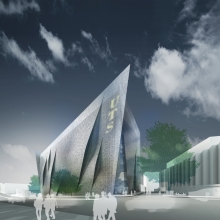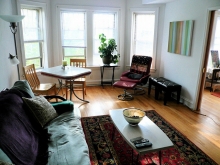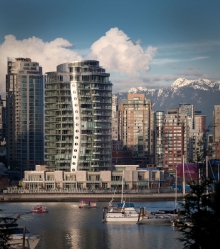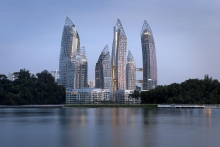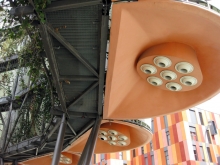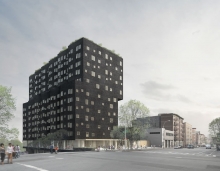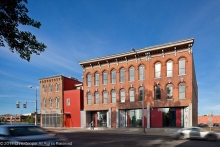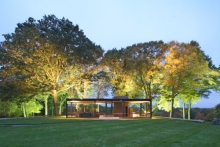The University of Technology Sydney, Australia (UTS) solicited design proposals for a new building to house its Faculty of Engineering and Information Technology as part of the school�s Broadway Building Design Competition. The school was in search of an architecture firm that could design a �gateway� building that referenced the urban context and the City Campus Master Plan while supporting a large population of students and faculty and reducing the school�s environmental impact. In July 2009, UTS announced the winning design, submitted by Australian architectural firm Denton Corker Marshall, from over 60 international entries. Selected by UTS representatives, the City of Sydney, and the New South Wales (NSW) Department of Planning, the design for the Information Technology and Engineering (ITE) Building was chosen for its aesthetic appeal, as well as its functionality and sustainable qualities.
Most Popular from All Topics
Small Spaces: Seven Ways to Live More Graciously
Oversized homes are going out of style. Check out these seven ways to live more graciously in a small space.
Are you ready for a pop quiz? True or false: it�s easier to live better when you have more.
Conventional wisdom would have us believe it�s true, but it�s 100% false, says designer John M. Stephens, ASID, owner of John M. Stephens Design in New Orleans. Living well is a way of being in your space and caring for your things. �Gracious living is living in the best possible way no matter what your circumstances are,� he says. It�s about taking the time to make the small details special, from how you display your favorite pieces to how you make guests feel welcome. �It�s really taking all the small pieces of your life and putting them together so they make the whole better,� Stephens says.
The Erickson Building
A new luxury residential tower in Vancouver provides a twist on the typology
It�s not hard to imagine why developers flock to the waterfront of Vancouver, British Columbia. Concord Pacific Group has built many high-rise glass and concrete residential towers there, but the Erickson Building � a new 17-story, 61-unit development � stands out among their portfolio. Designed in the style of legendary Canadian architect Arthur Erickson, known for his modernist concrete structures, the Erickson�s twisting form rotates counterclockwise and then shifts clockwise, evoking the motion of the water below. Between concrete columns, expanses of glass capture panoramic views of downtown Vancouver, False Creek, the Strait of Georgia, and the Pacific Ocean beyond.
Reflections at Keppel Bay by Studio Daniel Libeskind
Daniel�Libeskind softened his signature approach when designing a symphony of curving residential towers along Singapore�s waterfront.
Watts It Matter to You? Electricity Generation
The Cost and Reliability of Electricity Service
The American Society of Civil Engineers (ASCE) assigned the United States� ENERGY infrastructure a grade of �D+� on their 2009 Report Card for America�s Infrastructure. Electricity generation is the first of three installments on energy and covers nuclear, coal and natural gas, and hydro-electric power generating facilities. Electrical transmission and distribution will be covered in installments two and three as we follow the path of electricity from a power generating facility to your home or business. The goal is to provide an overview on how electrical power is delivered, including issues of current concern.
5 Green Home Trends for 2012
Green is here to stay! Here�s what to watch for in the next few months.
With 2011 quickly drawing to a close, it�s time to take out our crystal ball and conjure up the green home trends that will shape our choices in the coming year. Many of these trends will sound very familiar; some have evolved out of economic necessity, while others exist thanks to great advances in technology. Whether you already own a home or plan to build a new one, there�s bound to be at least one trend that appeals to you.
The NAHB International Builders' Show is the place to go to check out the latest building products. Jeff Wilson attended the 2012 show in Orlando and here shares his favorite finds.
There's nothing like escaping the Midwest and going to Florida in the middle of winter. That�s what I got to do recently in Orlando at the National Association of Homebuilders� International Builders� Show 2012. While I attended as a host and presenter for LP Building Products, I also got a chance to check out the booths and exhibits.
Much to the chagrin of many Spanish bar owners and restaurateurs, 2011 rang in the New Year with strict (and controversial) anti-smoking laws on January 2. For Spain and its �live and let live� attitude, these new regulations mark the end of an era for the country and its strong caf� culture of tapas, beer, and smoke. While the country is dedicated to eliminating smoke-filled spaces, Madrid is taking it one step further by actually creating healthy air one neighborhood at a time � starting with the Vallecas neighborhood south of the city. After years of ongoing development and poor city planning, the city council of Vallecas realized that the area was severely lacking in green areas. The city of Madrid (along with the European Union) launched a competition looking for architects that could create a viable social design that reflected the community�s environment-friendly goals.
Infrastructure at Work: Summersville Dam, WV
Summersville Dam, in south central West Virginia, is the second largest rock-fill dam in the eastern United States and exemplifies the way a dam can provide multiple enhancements, such as recreational activities, flood control, and electricity generation, to the local community.
Home Sweet Harlem: Modern and Affordable Housing in Sugar Hill
David Adjaye, the designer of the National Museum of African American History and Culture on the National Mall in Washington DC, also designed some of the most affordable housing in Manhattan. Harlem's Sugar Hill Housing Development by Adjaye Associates is now accepting applications.
Broadway Housing Communities, a nonprofit developer of supportive housing, alters the urban landscape of northern Manhattan by building affordable housing projects that showcase the work of local artists. They selected London-based Adjaye Associates -- founded by David Adjaye, who is leading the team behind the Smithsonian African American Museum of History and Culture on the Washington Mall -- to design their seventh housing project in Sugar Hill, a historic district of Harlem.
Island in the Stream: A Recording Studio Bracketed by Traffic
SubCat Studios by Fiedler Marciano Architecture
The addition of an independent recording studio was an ideal fit for Syracuse, New York�s burgeoning local arts scene, but who would consider building a recording studio on a site surrounded by noise?
Although it is situated between downtown Syracuse�s Armory Square district and the Near Westside, two artsy neighborhoods on the rise, the Redhouse Arts Center is physically isolated. The 89-seat theater occupies a "private island" of sorts, severed from the urban fabric by highly trafficked roads and a freight rail overpass. Now it is no longer alone. When the adjacent three-story masonry structure known as 219 West became available, a benefactor of the Redhouse Arts Center, who is also an associate of the owner of SubCat Studios, saw a mutually beneficial opportunity to cement this little island�s status as a cultural destination.
In September 2011, publisher Rizzoli New York released The Glass House, a photo tour of Philip Johnson�s famous estate. The book includes text by Philip Johnson himself and by architecture critic Paul Goldberger and is the official Glass House book of The National Trust for Historic Preservation. Robin Hill�s photo �Glass House Dawn� was selected to appear on the book�s cover.
Below is the second of a three-part installment wherein Robin Hill shares his experience of photographing the Glass House estate. Read part one here.
Now I am making my way the few steps toward the lakeside pavilion. Here Johnson is up to new tricks. As I approach the lakeside, I am reminded of the London Underground loudspeaker system, which brusquely ejaculates "MIND THE GAP" every time you board or deboard a train. Instead of designing the pavilion to gently nudge the shoreline, there's this intentional but irritating gap that Johnson has deliberately placed in one's way. Why? My first thought is "to mess with your head" or perhaps it is to make you pay attention. OK, so now I'm paying attention, and the impression is that ordinary scale has been obliterated by the architect's hands. This is a perfect modern folly. It is barely functional, save to sit underneath and have an uncomfortable picnic. Through these photographer's eyes excellent framing opportunities are created by the multiple archways. The visual pun is too obvious for my taste, however, and the pavilion does nothing for me in an architectural sense. I begin to feel that this is a dud, a Johnson experiment that doesn't really work very well in either form or function. Perhaps, this is indicative of Johnson's uneven career as an architect, brilliant one minute and mediocre the next. In the space of a few steps I have gone from momentous elevation to ungarnished mediocrity, from design excellence to controlled vacuousness. Still, the adventure of being here leaves my intellect alone for a while and I am left in solitude in the middle of a 46-acre design campus. Heaven! There is a serenity here that is both palpable and meaningful.
